Biochimica et Biophysica Acta (BBA) - Molecular and Cell Biology of Lipids ( IF 4.8 ) Pub Date : 2020-11-04 , DOI: 10.1016/j.bbalip.2020.158853 Tianci Jiang , Lingling Dai , Pengfei Li , Junwei Zhao , Xi Wang , Lin An , Meng Liu , Shujun Wu , Yu Wang , Youmei Peng , Di Sun , Caopei Zheng , Tingting Wang , Xuejun Wen , Zhe Cheng

|
Background
Lipids participate in many important biological functions through energy storage, material transport, signal transduction, and molecular recognition processes. Studies have reported that asthmatic patients have abnormal lipid metabolism. However, there are limited studies on the characterization of lipid metabolism in asthmatic patients by lipidomics.
Methods
We characterized the plasma lipid profile of 28 healthy controls and 33 outpatients with asthma (18 mild, 15 moderate) by liquid chromatography mass spectrometry/mass spectrometry-based lipidomics.
Results
We determined 1338 individual lipid species in the plasma. Significant changes were identified in ten lipid species in asthmatic patients than in healthy controls (all P < 0.05). Phosphatidylethanolamine (PE) (18:1p/22:6), PE (20:0/18:1), PE (38:1), sphingomyelin (SM) (d18:1/18:1), and triglyceride (TG) (16:0/16:0/18:1) positively correlated with the severity of asthma (all P < 0.05). Phosphatidylinositol (PI) (16:0/20:4), TG (17:0/18:1/18:1), phosphatidylglycerol (PG) (44:0), ceramide (Cer) (d16:0/27:2), and lysophosphatidylcholine (LPC) (22:4) negatively correlated with the severity of asthma (all P < 0.05). Correlation analysis showed a significant correlation between all ten lipid species (all P < 0.05). From the area under the curve of the receiver operating characteristic curve analysis, PE (38:1) was the major lipid metabolite that distinguished asthmatic patients from healthy controls, and may be considered a potential lipid biomarker. PE (20:0/18:1) and TG (16:0/16:0/18:1) might be related to IgE levels in asthmatic patients.
Conclusions
Our results indicated the presence of abnormal lipid metabolism, which correlated with the severity and IgE levels in asthmatic patients.
中文翻译:

脂质组学分析哮喘中的脂质代谢和生物标志物
背景
脂质通过能量存储,物质运输,信号转导和分子识别过程参与许多重要的生物学功能。研究报告说,哮喘患者的脂质代谢异常。然而,关于通过脂质组学对哮喘患者的脂质代谢进行表征的研究很少。
方法
我们通过基于液相色谱质谱/质谱的脂质组学对28位健康对照和33位哮喘(18位轻度,15位中度)门诊患者的血浆脂质谱进行了表征。
结果
我们确定了血浆中的1338个单独的脂质种类。与健康对照组相比,哮喘患者的十种脂质中发现了显着变化(所有P <0.05)。磷脂酰乙醇胺(PE)(18:1p / 22:6),PE(20:0/18:1),PE(38:1),鞘磷脂(SM)(d18:1/18:1)和甘油三酸酯(TG )(16:0/16:0/18:1)与哮喘的严重程度呈正相关(所有P <0.05)。磷脂酰肌醇(PI)(16:0/20:4),TG(17:0/18:1/18:1),磷脂酰甘油(PG)(44:0),神经酰胺(Cer)(d16:0/27: 2)和溶血磷脂酰胆碱(LPC)(22:4)与哮喘的严重程度呈负相关(所有P <0.05)。相关分析表明,所有十种脂质物种之间均存在显着相关性(所有P <0.05)。从接受者工作特征曲线分析的曲线下面积来看,PE(38:1)是区分哮喘患者和健康对照者的主要脂质代谢产物,可能被认为是潜在的脂质生物标志物。PE(20:0/18:1)和TG(16:0/16:0/18:1)可能与哮喘患者的IgE水平有关。
结论
我们的结果表明存在异常的脂质代谢,这与哮喘患者的严重程度和IgE水平相关。



























 京公网安备 11010802027423号
京公网安备 11010802027423号